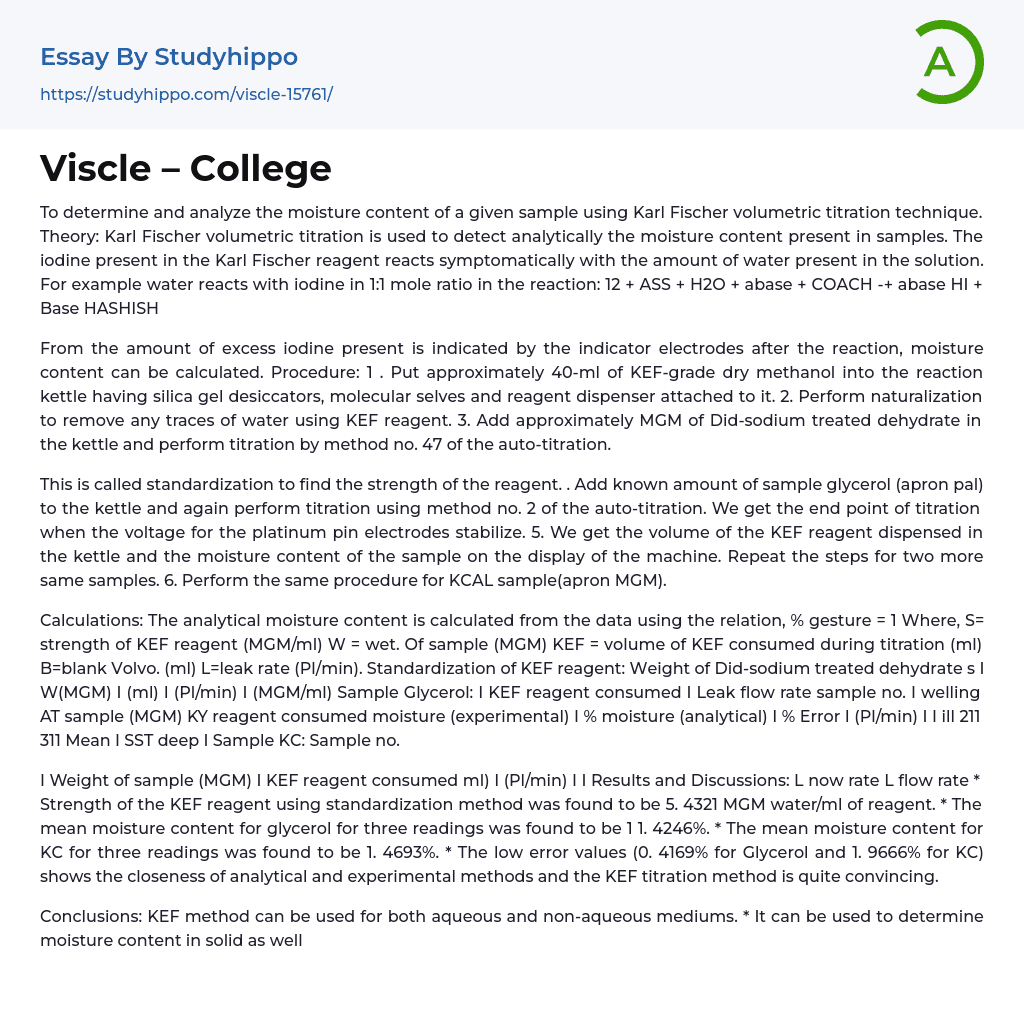To determine and analyze the moisture content of a given sample using the Karl Fischer volumetric titration technique, the following steps are taken. The Karl Fischer volumetric titration method detects the moisture content in samples by reacting the iodine present in the Karl Fischer reagent with water in a 1:1 mole ratio. The reaction can be represented as:
I2 + ASS + H2O + abase + COACH -> abase HI + Base HASHISH
The excess iodine present after the reaction is indicated by the indicator electrodes, allowing for the calculation of moisture content. The procedure involves adding approximately 40-ml of KEF-grade dry methanol into a reaction kettle equipped with silica gel desiccators, molecular selves, and a reagent dispenser. Naturalization is then performed using KEF reagent to remove any traces of water. Next, approximately MGM of Did-sodium treated dehydr
...ate is added to the kettle, and titration is carried out following method no.47 of the auto-titration process.
This step is referred to as standardization, as it determines the strength of the reagent. Once standardized, a known amount of sample glycerol (apron pal) is added to the kettle, and titration is performed again using method no.2 of the auto-titration process. The end point of titration is reached when the voltage for the platinum pin electrodes stabilizes. The volume of KEF reagent dispensed in the kettle and the moisture content of the sample are displayed on the machine.Repeat the steps for two additional samples of the same type. Then, perform the same procedure for the KCAL sample (apron MGM).
Calculations:
The analytical moisture content is calculated from the data using the following relation: % gesture = 1.
Where,
S = strength of KEF reagent
(MGM/ml)
W = wet.Of sample (MGM)
KEF = volume of KEF consumed during titration (ml)
B = blank Volvo.(ml)
L = leak rate (Pl/min).
Standardization of KEF reagent:
Weight of Did-sodium treated dehydrate s I W(MGM) I (ml) I (Pl/min) I (MGM/ml)
Sample Glycerol: I KEF reagent consumed I Leak flow rate sample no.I welling AT sample (MGM) KY reagent consumed moisture (experimental) I % moisture (analytical) I % Error I (Pl/min) I I ill 211 311 Mean I SST deep I
Sample KC:
Sample no.
Weight of sample (MGM) I KEF reagent consumed ml) I (Pl/min)
Results and Discussions:
The strength of the KEF reagent using the standardization method was found to be 5.4321 MGM water/ml of reagent.
The mean moisture content for glycerol for three readings was found to be 11.4246%.
The mean moisture content for KC for three readings was found to be 11.4693%.
The low error values (0.4169% for Glycerol and 1.9666% for KC) demonstrate the close agreement between analytical and experimental methods, indicating that the KEF titration method is reliable.
Conclusions:
The KEF method can be applied to both aqueous and non-aqueous mediums.
It can be used for determining moisture content in both solid and liquid samples.Our approach minimizes errors caused by sample volatility since it relies on liquid media reactions. To ensure accurate measurements, it is important to consider the weight of the sample attached to the spatula or pipette. When adding the sample to the kettle, make sure it falls directly into the solution to prevent it from sticking to the inner wall of the vessel and causing errors.
- Professor essays
- Should College be Free essays
- Should college athletes be paid essays
- College Education essays
- College Tuition essays
- Graduation essays
- College Goals essays
- Personal Statement essays
- Online Classes Vs Traditional Classes essays
- Online Education essays
- Student Loan essays
- Study Abroad Scholarship essays
- Reasons To Go To College essays
- Paying College Athletes essays
- Technology In The Classroom essays
- Classroom essays
- College essays
- E-Learning essays
- Elementary School essays
- Examination essays
- Graduate School essays
- High School essays
- History Of Education essays
- Homeschooling essays
- Kindergarten essays
- Middle School essays
- Public School essays
- School essays
- Single Sex Schools essays
- Special Education essays
- Student essays
- Teacher essays
- University essays
- Vocational Education essays
- Acid essays
- Calcium essays
- Carbohydrate essays
- Carbon essays
- Chemical Bond essays
- Chemical Reaction essays
- Chemical reactions essays
- Chromatography essays
- Concentration essays
- Copper essays
- Diffusion essays
- Ethanol essays
- Hydrogen essays
- Organic Chemistry essays
- Osmosis essays
- Periodic Table essays




